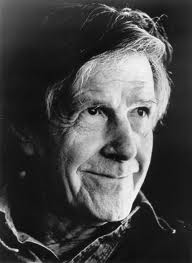Cage, John
Biography
Born: September 05, 1912 - Los Angeles, California, U.S.A
Died: August 12, 1992 - New York City
Country: Los Angeles, California, U.S.A
Studies: Pomona College, California, UCLA
Teachers: Richard Buhlig, A. Weiss, A. Schoenberg
Mention: Inducted into the Percussive Arts Society (1999) PAS Hall of Fame[1]
John Cage, in full John Milton Cage, Jr. (born September 5, 1912, Los Angeles, California, U.S.—died August 12, 1992, New York, New York), American avant-garde composer whose inventive compositions and unorthodox ideas profoundly influenced mid-20th-century music.
The son of an inventor, Cage briefly attended Pomona College and then traveled in Europe for a time. Returning to the United States in 1931, he studied music with Richard Buhlig, Arnold Schoenberg, Adolph Weiss, and Henry Cowell. While teaching in Seattle (1938–40), Cage organized percussion ensembles to perform his compositions. He also experimented with works for dance, and his subsequent collaborations with the choreographer and dancer Merce Cunningham sparked a long creative and romantic partnership.
Cage’s early compositions were written in the 12-tone method of his teacher Schoenberg, but by 1939 he had begun to experiment with increasingly unorthodox instruments such as the “prepared piano” (a piano modified by objects placed between its strings in order to produce percussive and otherworldly sound effects). Cage also experimented with tape recorders, record players, and radios in his effort to step outside the bounds of conventional Western music and its concepts of meaningful sound. The concert he gave with his percussion ensemble at the Museum of Modern Art in New York City in 1943 marked the first step in his emergence as a leader of the American musical avant-garde.
In the following years, Cage turned to Zen Buddhism and other Eastern philosophies and concluded that all the activities that make up music must be seen as part of a single natural process. He came to regard all kinds of sounds as potentially musical, and he encouraged audiences to take note of all sonic phenomena, rather than only those elements selected by a composer. To this end he cultivated the principle of indeterminism in his music. He used a number of devices to ensure randomness and thus eliminate any element of personal taste on the part of the performer: unspecified instruments and numbers of performers, freedom of duration of sounds and entire pieces, inexact notation, and sequences of events determined by random means such as by consultation with the Chinese Yijing (I Ching). In his later works he extended these freedoms over other media, so that a performance of HPSCHD (completed 1969) might include a light show, slide projections, and costumed performers, as well as the 7 harpsichord soloists and 51 tape machines for which it was scored.
Among Cage’s best-known works are 4′33″ (Four Minutes and Thirty-three Seconds, 1952), a piece in which the performer or performers remain utterly silent onstage for that amount of time (although the amount of time is left to the determination of the performer); Imaginary Landscape No. 4 (1951), for 12 randomly tuned radios, 24 performers, and conductor; the Sonatas and Interludes (1946–48) for prepared piano; Fontana Mix (1958), a piece based on a series of programmed transparent cards that, when superimposed, give a graph for the random selection of electronic sounds; Cheap Imitation (1969), an “impression” of the music of Erik Satie; and Roaratorio (1979), an electronic composition utilizing thousands of words found in James Joyce’s novel Finnegans Wake.
Cage published several books, including Silence: Lectures and Writings (1961) and M: Writings ’67–’72 (1973). His influence extended to such established composers as Earle Brown, Lejaren Hiller, Morton Feldman, and Christian Wolff. More broadly, his work was recognized as significant in the development of traditions ranging from minimalist and electronic music to performance art.[2]
Works for Percussion
27' 10.554" for a Percussionist - Multiple Percussion
Amores - Percussion Trio; Piano
Branches - Percussion Duo
But what about the noise of crumpling paper.....? - Percussion Sextet
Child of Tree - Multiple Percussion
Composed Improvisation for Snare Drum - Snare Drum
Composed Improvisation: for one-sided drum with or without jangles - Multiple Percussion
Composed Improvisation: for Snare Drum Alone - Snare Drum
Credo in US - Percussion Quartet
Dance Music: for Elfrid Ide - Percussion Sextet; Dancer
Double Music - Percussion Quartet - Cage/Harrison
First Construction (in metal) - Percussion Quintet; Piano
Forever and Sunsmell - Percussion Duo; Voice
Four4 - Percussion Quartet
Imaginary Landscape No.2 - Percussion Quintet
Imaginary Landscape No.3 - Percussion Sextet
Imaginary Landscape No.4 or March No. 2 - 12 Radios - 24 Players
Inlets - Percussion Trio; Conch Shells
Living Room Music - Percussion Quartet
One4 - Multiple Percussion
Quartet - Percussion Quartet
R= Ryoanji - Multiple Percussion
Second Construction - Percussion Trio; Piano
She is Asleep: Quartet - Percussion Quartet; Voice; Piano
Six - Percussion Sextet
The Wonderful Widow of Eighteen Springs Multiple Percussion (Piano); Voice
Third Construction - Percussion Quartet
Three2 - Percussion Trio
Trio - Percussion Trio
References
- ↑ PAS.org Accessed March 23, 2013
- ↑ http://www.britannica.com/biography/John-Cage Accessed 2/24/16
- Composers
- American Composers
- History
- History-Composers
- History-Performers
- LGBTQ Composers
- Percussion Ensemble
- Solo Percussion
- Multiple Percussion
- Snare Drum
- Percussion Duet
- Percussion Duo
- Percussion (2)
- Percussion Trio
- Percussion (3)
- Percussion Quartet
- Percussion (4)
- Percussion Quintet
- Percussion (5)
- Percussion Sextet
- Percussion (6)
- PAS Hall of Fame
